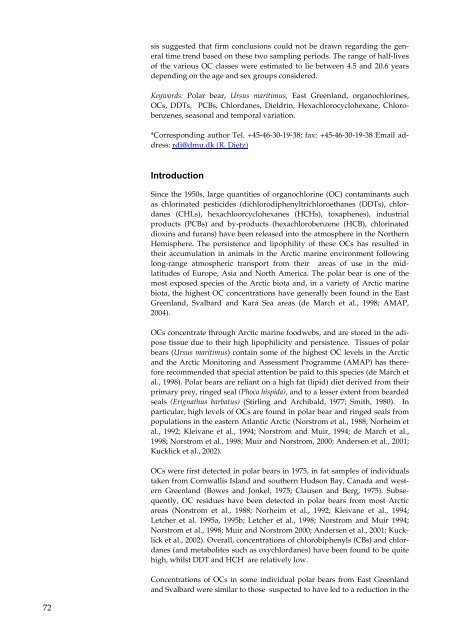Organohalogen concentrations and a gross and histologic ...
Organohalogen concentrations and a gross and histologic ...
Organohalogen concentrations and a gross and histologic ...
You also want an ePaper? Increase the reach of your titles
YUMPU automatically turns print PDFs into web optimized ePapers that Google loves.
72<br />
sis suggested that firm conclusions could not be drawn regarding the general<br />
time trend based on these two sampling periods. The range of half-lives<br />
of the various OC classes were estimated to lie between 4.5 <strong>and</strong> 20.6 years<br />
depending on the age <strong>and</strong> sex groups considered.<br />
Keywords: Polar bear, Ursus maritimus, East Greenl<strong>and</strong>, organochlorines,<br />
OCs, DDTs, PCBs, Chlordanes, Dieldrin, Hexachlorocyclohexane, Chlorobenzenes,<br />
seasonal <strong>and</strong> temporal variation.<br />
*Corresponding author Tel. +45-46-30-19-38; fax: +45-46-30-19-38 Email address:<br />
rdi@dmu.dk (R. Dietz)<br />
Introduction<br />
Since the 1950s, large quantities of organochlorine (OC) contaminants such<br />
as chlorinated pesticides (dichlorodiphenyltrichloroethanes (DDTs), chlordanes<br />
(CHLs), hexachloorcyclohexanes (HCHs), toxaphenes), industrial<br />
products (PCBs) <strong>and</strong> by-products (hexachlorobenzene (HCB), chlorinated<br />
dioxins <strong>and</strong> furans) have been released into the atmosphere in the Northern<br />
Hemisphere. The persistence <strong>and</strong> lipophility of these OCs has resulted in<br />
their accumulation in animals in the Arctic marine environment following<br />
long-range atmospheric transport from their areas of use in the midlatitudes<br />
of Europe, Asia <strong>and</strong> North America. The polar bear is one of the<br />
most exposed species of the Arctic biota <strong>and</strong>, in a variety of Arctic marine<br />
biota, the highest OC <strong>concentrations</strong> have generally been found in the East<br />
Greenl<strong>and</strong>, Svalbard <strong>and</strong> Kara Sea areas (de March et al., 1998; AMAP,<br />
2004).<br />
OCs concentrate through Arctic marine foodwebs, <strong>and</strong> are stored in the adipose<br />
tissue due to their high lipophilicity <strong>and</strong> persistence. Tissues of polar<br />
bears (Ursus maritimus) contain some of the highest OC levels in the Arctic<br />
<strong>and</strong> the Arctic Monitoring <strong>and</strong> Assessment Programme (AMAP) has therefore<br />
recommended that special attention be paid to this species (de March et<br />
al., 1998). Polar bears are reliant on a high fat (lipid) diet derived from their<br />
primary prey, ringed seal (Phoca hispida), <strong>and</strong> to a lesser extent from bearded<br />
seals (Erignathus barbatus) (Stirling <strong>and</strong> Archibald, 1977; Smith, 1980). In<br />
particular, high levels of OCs are found in polar bear <strong>and</strong> ringed seals from<br />
populations in the eastern Atlantic Arctic (Norstrom et al., 1988; Norheim et<br />
al., 1992; Kleivane et al., 1994; Norstrom <strong>and</strong> Muir, 1994; de March et al.,<br />
1998; Norstrom et al., 1998; Muir <strong>and</strong> Norstrom, 2000; Andersen et al., 2001;<br />
Kucklick et al., 2002).<br />
OCs were first detected in polar bears in 1975, in fat samples of individuals<br />
taken from Cornwallis Isl<strong>and</strong> <strong>and</strong> southern Hudson Bay, Canada <strong>and</strong> western<br />
Greenl<strong>and</strong> (Bowes <strong>and</strong> Jonkel, 1975; Clausen <strong>and</strong> Berg, 1975). Subsequently,<br />
OC residues have been detected in polar bears from most Arctic<br />
areas (Norstrom et al., 1988; Norheim et al., 1992; Kleivane et al., 1994;<br />
Letcher et al. 1995a, 1995b; Letcher et al., 1998; Norstrom <strong>and</strong> Muir 1994;<br />
Norstrom et al., 1998; Muir <strong>and</strong> Norstrom 2000; Andersen et al., 2001; Kucklick<br />
et al., 2002). Overall, <strong>concentrations</strong> of chlorobiphenyls (CBs) <strong>and</strong> chlordanes<br />
(<strong>and</strong> metabolites such as oxychlordanes) have been found to be quite<br />
high, whilst DDT <strong>and</strong> HCH are relatively low.<br />
Concentrations of OCs in some individual polar bears from East Greenl<strong>and</strong><br />
<strong>and</strong> Svalbard were similar to those suspected to have led to a reduction in the

















